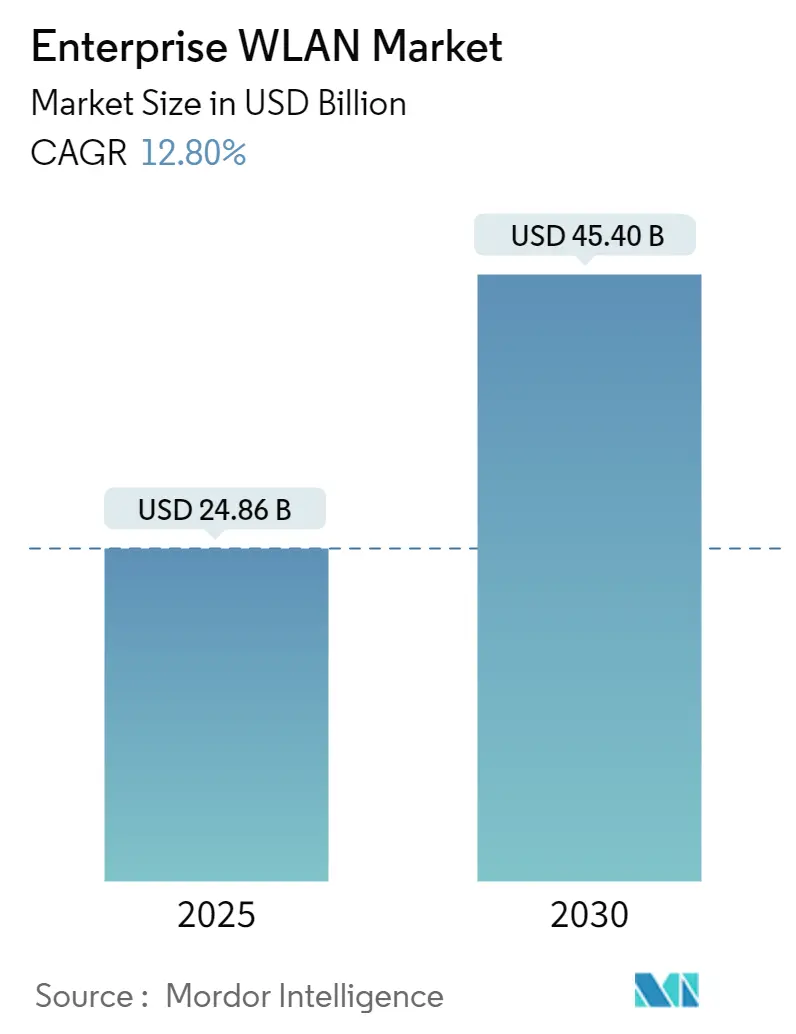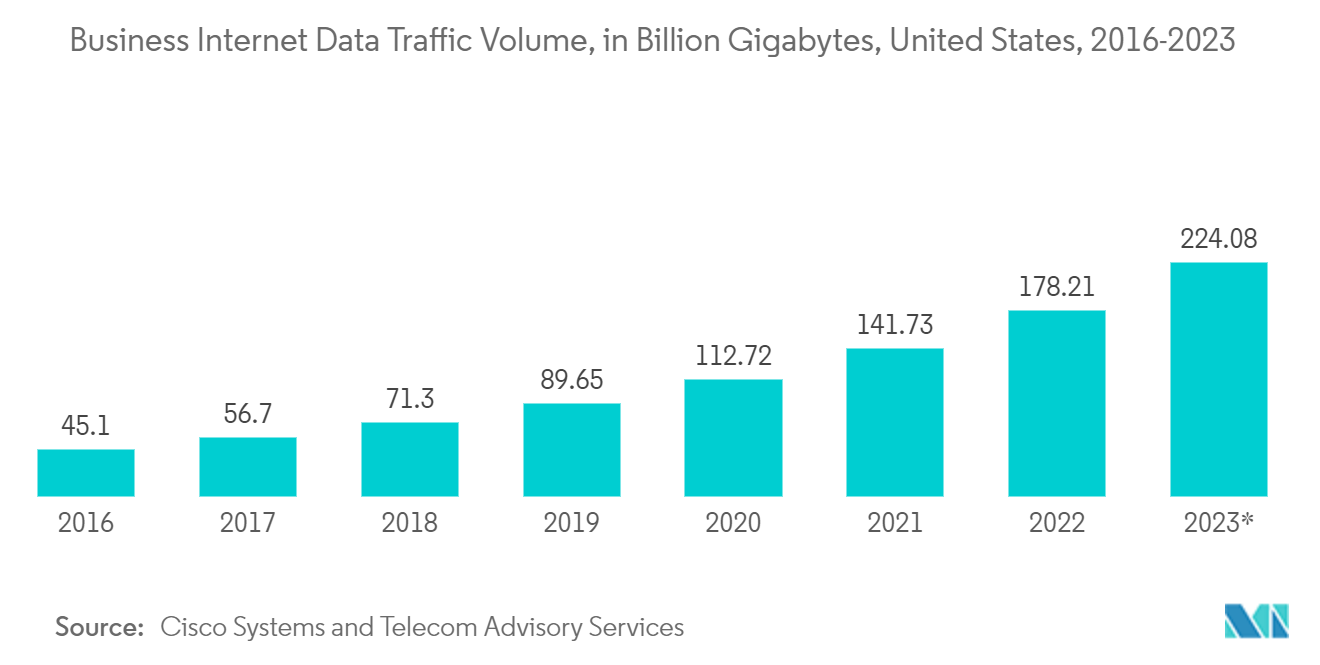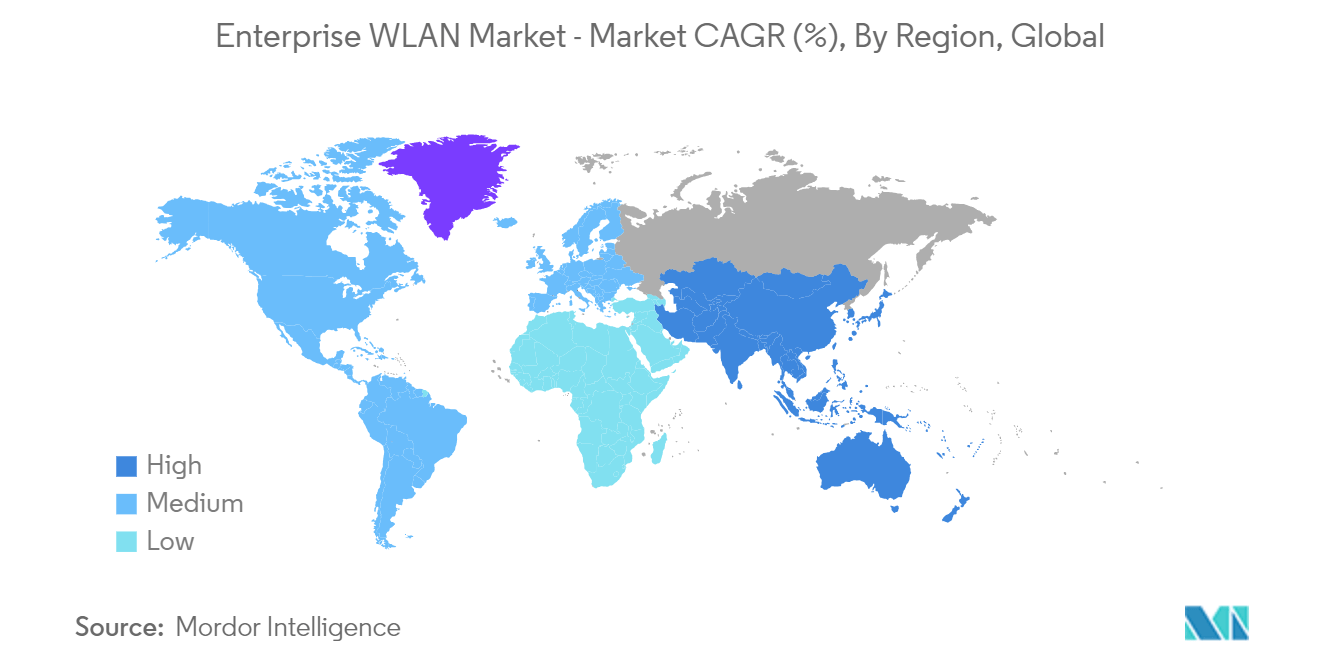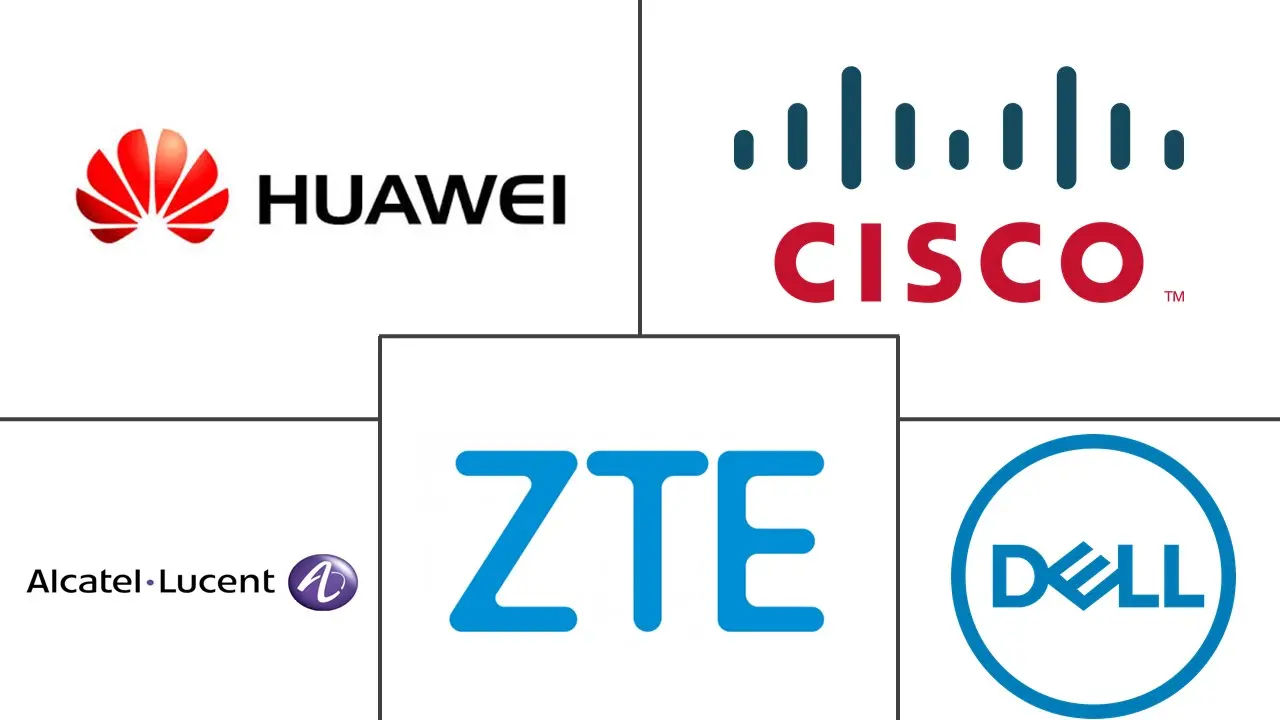
Enterprise WLAN Market Analysis
The Enterprise WLAN Market size is estimated at USD 24.86 billion in 2025, and is expected to reach USD 45.40 billion by 2030, at a CAGR of 12.8% during the forecast period (2025-2030).
The Enterprise WLAN market continues to grow rapidly, emphasizing the importance of wireless technology in the network and digital transformation goals of organizations across the globe.
- The growth of the Enterprise WLAN market is attributed to the increasing demand for reliable, high-speed, and secure wireless networks that can support the growing number of connected devices in the workplace.
- As many organizations are moving their applications and data to the cloud, the requirement for a robust wireless network that can handle the increased traffic and bandwidth demands is increased. Also, as the number of devices connected to a wireless network increases, so does the risk of security breaches that can be protected using advanced security features provided by Enterprises' WLAN solutions.
- The continuous growth of network infrastructure, increased demand for high-speed internet, and introduction of new wireless standards named WIFI6, also known as 802.11ax, is expected to impact the market positively. Also, regularly updating standards improves network throughput in terms of maximum speeds and transmission capabilities.
- The high cost associated with the deployment and maintaining Enterprise WLAN for small and medium-sized businesses is challenging for the growth of the Enterprise WLAN market.
- COVID-19 impacted Enterprise WLAN usage and deployment. The pandemic accelerated the adoption of enterprise WLAN solutions that support remote work and provide greater flexibility and scalability. It also highlighted WLAN security and the need for organizations to be able to adapt to changing traffic patterns. However, the pandemic also caused delays and challenges for WLAN deployment projects, which long-term impacted WLAN adoption and usage.
Enterprise WLAN Market Trends
Increasing Data Traffic and Demand for High Speed Data Connectivity to Drive the Growth of the Market
- With the growing adoption of cloud-based applications, the demand for data traffic has increased tremendously. As more and more businesses move their applications to the cloud, they require reliable and fast internet connectivity to ensure their operation runs smoothly. Enterprise WLAN solutions provide this connectivity by offering high-speed data transmission rates, which allow businesses to transfer data quickly and efficiently.
- Business internet data traffic is growing as more businesses adopt digital technologies in their operations. In 2022, the business internet data traffic in the United States reached 178.21 billion gigabytes from 141.73 billion gigabytes in 2021.
- In addition, the demand for high-speed data has increased substantially in recent years due to the growing number of devices connected to enterprise networks. Employees now use multiple devices to access company data and applications, which requires robust and high-speed data transmission capabilities that can be achieved with enterprise WLAN solutions.
- Moreover, the increased emphasis of organizations on creating a digital and wireless workplace within premise mobility has become a major driving factor for the market's growth. Also, the increasing trend of BYOD and digital transformation is making enterprises consider broader enterprise campuses, which will fuel the market's growth in the coming year.
- Due to increased demand, several media and telecom companies are investing in high-speed data services. For instance, in December 2022, Social media giant Meta and Bharti Airtel collaborated to invest in telecom infrastructure to cater to the rising demand for high-speed data and digital services in India to support the emerging requirements of customers and enterprises.

North America is Expected to Hold the Largest Market Share
- North America has a high adoption rate of mobile devices such as smartphones, tablets, and laptops, which has led to an increased demand for wireless connectivity. This has driven the growth of the enterprise WLAN market as businesses seek to provide reliable, high-speed wireless connectivity to their employees and customers. Also, the high level of internet penetration, with a large percentage of the population having access to the internet, led to higher demand for wireless connectivity, supporting the market's growth.
- The continuously increasing consumption of smartphones has led organizations in the region to adopt BYOD on a large scale; therefore, good coverage inside office spaces becomes essential. This represents a potential opportunity for the in-building office providers, fueling the market's growth over the forecast period.
- The growing deployment of 5G in North America is helping to drive the growth of the Enterprise WLAN market by providing increased network capacity, faster speed, improved reliability, enhanced security, and improved IoT capabilities. This creates new opportunities for Enterprise WLAN vendors and drives demand for their products and services.
- According to CTIA's 2022 Annual Wireless Industry Survey, The United States wireless industry invested nearly USD 35 billion to grow, improve and run their networks in 2021. This investment drives unparalleled results of 5G networks covering over 315 million Americans. Also, the survey states that wireless capital investment is speeding up 5G deployment.
- Moreover, the growing adoption of cloud computing in North America is increasing rapidly. Businesses rely on cloud-based applications and services, which need reliable and high-speed wireless connectivity, leading to increased demand for WLAN solutions to support cloud-based applications.

Enterprise WLAN Industry Overview
The enterprise WLAN market is highly competitive and consists of several major players. In terms of market share, few of the major players currently dominate the market. These major players with prominent shares in the market are focusing on expanding their customer base worldwide.
In September 2023 - Huawei announced to launch of three Product Portfolios for the Commercial Market to Build High-Quality Connections, including Huawei Zero-Roaming Distributed Wi-Fi solution, Huawei High-Quality Simplified Data Center Network Solution, High-Quality SME Office as there are a large number of SMEs, which are critical to economic development. Huawei will develop more marketable products and portfolios to help partners win more customers and succeed in the commercial market.
In October 2022, IO by HFCL launched the Wi-Fi 7 enterprise-grade Wi-Fi access points revealing the two new devices (indoor and outdoor versions) at the India Mobile Congress. The new access points are designed for open-source networking, are OpenWiFi-ready, and are powered by Qualcomm's Networking Pro platform.
In August 2022, Extreme Networks Inc., one of the leaders in cloud networking, introduced the Extreme AP5050: the industry's first outdoor Wi-Fi 6E Outdoor Access Point (AP) optimized for installation at outdoor venues, convention centers, hospital and university campuses, and large stadiums, among others. It delivers enhanced wireless experiences, faster speeds, and reduced interference. It enables large outdoor venues to operate across up to three times as much spectrum as previous generations of Wi-Fi.
Enterprise WLAN Market Leaders
-
Cisco Systems Inc.
-
Huawei Technologies Co. Ltd.
-
Alcatel Lucent Enterprises
-
Dell Inc.
-
ZTE Corporation
- *Disclaimer: Major Players sorted in no particular order
Enterprise WLAN Market News
- July 2023: EnGenius Technologies Inc., one of the leading providers of advanced connectivity solutions, unveiled the Cloud Wi-Fi 7 connectivity series for enterprises. The Qualcomm Networking Pro 1220 platform powers the ECW536. It is the cloud-managed Wi-Fi 7 4x4x4 Wireless Access Point, is explicitly designed for enterprise-level environments, and is the launch in the series. Setting new benchmarks in wireless connectivity, the ECW536 empowers organizations to embrace the future of wireless networking with the all-new Wi-Fi 7 (IEEE 802.11be) Standard and ultra-fast aggregate speeds of up to 18.8 Gbps.
- July 2022: Zyxel Communications launched EX2210 Dual-Band Wireless AX1800 Gigabit Gateway. The is a WiFi 6 gateway that provides a seamless WiFi experience and superior, feature-rich wireless connectivity to deliver high-performance internet access services throughout the home or office. Also, EX2210 delivers high-speed internet access and Quality of Service (QoS) support that enables service providers to meet the growing demand from their subscribers for triple-play services.
- January 2022: Comcast announced its next-generation xFi Advanced Gateway incorporating WiFi 6E, offering customers an unbeatable broadband experience with a faster, more reliable wireless connection. The new gateway will boost capacity in the home with three WiFi bands 2.4 GHz, 5 GHz, and a new 6 GHz band.
Enterprise WLAN Industry Segmentation
A wireless LAN (WLAN) is a wireless network that links two or more devices using wireless communication to make an area network (LAN) within a limited area like a home, school, computer laboratory, campus, or office block, allowing the user with quicker downloads, outstanding network reliability, making businesses more efficient. It allows users to move around within the region and remain connected to the network. A WLAN can also connect to the broader Internet through a gateway. Enterprise Wireless LANs are mostly based on IEEE 802.11 standards and are sold under the Wi-Fi brand name.
The Enterprise WLAN Market is segmented by Component (hardware, software, services), organization size (large enterprises, small and medium-sized enterprises), end-user (retail, healthcare, banking, financial services, and insurance), and geography (North America, Europe, Asia Pacific, Latin America, Middle East and Africa). The report offers market forecasts and size in value (USD) for all the above segments.
| By Component | By Hardware | Access points | |
| WLAN Controllers | |||
| Wireless Hotspot Gateways | |||
| By Software | WLAN Security | ||
| WLAN Management | |||
| WLAN Analytics | |||
| Other Softwares | |||
| By Services | Professional Services | ||
| By Organization Size | Large Enterprises | ||
| Small and Medium-Sized Enterprises | |||
| By End-user Verticals | Banking, Financial Services and Insurance | ||
| Healthcare | |||
| Retail | |||
| IT and Telecommunications | |||
| Other End-user Verticals | |||
| Geography | North America | ||
| Europe | |||
| Asia Pacific | |||
| Latin America | |||
| Middle East and Africa | |||
Enterprise WLAN Market Research FAQs
How big is the Enterprise WLAN Market?
The Enterprise WLAN Market size is expected to reach USD 24.86 billion in 2025 and grow at a CAGR of 12.80% to reach USD 45.40 billion by 2030.
What is the current Enterprise WLAN Market size?
In 2025, the Enterprise WLAN Market size is expected to reach USD 24.86 billion.
Who are the key players in Enterprise WLAN Market?
Cisco Systems Inc., Huawei Technologies Co. Ltd., Alcatel Lucent Enterprises, Dell Inc. and ZTE Corporation are the major companies operating in the Enterprise WLAN Market.
Which is the fastest growing region in Enterprise WLAN Market?
Asia Pacific is estimated to grow at the highest CAGR over the forecast period (2025-2030).
Which region has the biggest share in Enterprise WLAN Market?
In 2025, the North America accounts for the largest market share in Enterprise WLAN Market.
What years does this Enterprise WLAN Market cover, and what was the market size in 2024?
In 2024, the Enterprise WLAN Market size was estimated at USD 21.68 billion. The report covers the Enterprise WLAN Market historical market size for years: 2019, 2020, 2021, 2022, 2023 and 2024. The report also forecasts the Enterprise WLAN Market size for years: 2025, 2026, 2027, 2028, 2029 and 2030.
Our Best Selling Reports
Enterprise WLAN Industry Report
Statistics for the 2025 Enterprise WLAN market share, size and revenue growth rate, created by Mordor Intelligence™ Industry Reports. Enterprise WLAN analysis includes a market forecast outlook for 2025 to 2030 and historical overview. Get a sample of this industry analysis as a free report PDF download.




